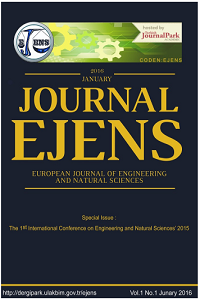Temporal Variation of Organic and Inorganic Carbon Transport from the Southeastern Black Sea (Trabzon Province) Rivers
Temporal Variation of Organic and Inorganic Carbon Transport from the Southeastern Black Sea (Trabzon Province) Rivers
Black Sea, Total Organic Carbon Trabzon Streams,
___
- [1]. Azizullah, A., Khattak, M. N. K., Richter, P., & Häder, D. P., Water pollution in Pakistan and its impact on public health—a review. Environment International, 37(2), 479-497, 2011.
- [2]. Anonymous. World Water Day 22.03.2010; 2010. Retrieved from www.worldwaterday2010.info, United Nations.
- [3]. Bakan, G., & Büyükgüngör, H., The black sea. Marine Pollution Bulletin,41(1), 24-43., 2000.
- [4]. Balkas, T., Dechev, G., Mihnea, R., Serbanescu, O., & Unlueata, U., State of the marine environment in the Black Sea Region. UNEP Regional Seas Reports and Studies,124, 47., 1990.
- [5]. Bayram, A., Onsoy, H., Bulut, V. N., & Akinci, G., Influences of urban wastewaters on the stream water quality: a case study from Gumushane Province, Turkey. Environmental Monitoring and Assessment, 185(2), 1285-1303., 2013.
- [6]. Boran, M., & Sivri, N., Trabzon (Türkiye) İl Sınırları İçerisinde Bulunan Solaklı ve Sürmene Derelerinde Nütrient ve Askıda Katı Madde Yüklerinin Belirlenmesi. E.U. Journal of Fisheries & Aquatic Sciences, 18,(3-4): 343 – 348, 2001.
- [7]. Bozcaarmutlu, A., Sapmaz, C., Aygun, Z., & Arinç, E., Assessment of pollution in the West Black Sea Coast of Turkey using biomarker responses in fish. Marine Environmental Research, 67, 167–176., 2009.
- [8]. Gültekin, F., Ersoy, A. F., Hatipoğlu, E., & Celep, S., Trabzon İli Akarsularının Yağışlı Dönem Su Kalitesi Parametrelerinin Belirlenmesi. Ekoloji,21(82), 77-88., 2012
- [9]. Koklu, R., Sengorur, B., & Topal, B., Water quality assessment using multivariate statistical methods—a case study: Melen River System (Turkey).Water Resources Management, 24(5), 959-978., 2010.
- [10]. Kumarasamy, P., James, R. A., Dahms, H. U., Byeon, C. W., & Ramesh, R., Multivariate water quality assessment from the Tamiraparani river basin, Southern India. Environmental Earth Sciences, 71(5), 2441-2451., 2014.
- [11]. Tuncer, G., Karakas, T., Balkas, T. I., Gökçay, C. F., Aygnn, S., Yurteri, C., & Tuncel, G., Land-based sources of pollution along the Black Sea coast of Turkey: concentrations and annual loads to the Black Sea. Marine Pollution Bulletin, 36(6), 409-423., 1998.
- [12]. TSWQR, Turkish Surface Water Quality Regulation. Official Gazette. no: 29327, Turkey, (in Turkish)., 2015.
- [13]. Varol, M., Gökot, B., Bekleyen, A., & Şen, B., Water quality assessment and apportionment of pollution sources of Tigris River (Turkey) using multivariate statistical techniques—a case study. River Research and Applications, 28(9), 1428-1438., 2012.
- [14]. Vieira, J. S., Pires, J. C., Martins, F. G., Vilar, V. J., Boaventura, R. A., & Botelho, C. M., Surface water quality assessment of Lis river using multivariate statistical methods. Water, Air, & Soil Pollution, 223(9), 5549-5561., 2012.
- [15]. Wan, J., Bu, H., Zhang, Y., & Meng, W., Classification of rivers based on water quality assessment using factor analysis in Taizi River basin, northeast China. Environmental Earth Sciences, 69(3), 909-919., 2013.
- [16]. Bulut, V. N., Bayram, A., Gundogdu, A., Soylak, M., & Tufekci, M., Assessment of water quality parameters in the stream Galyan, Trabzon, Turkey. Environmental Monitoring and Assessment, 165(1-4), 1-13., 2010.
- [17]. Alkan, A., Serdar, S., Fidan, D., Akbas, U., Zengin, B., & Kilic, M. B., Physico-Chemical Characteristics and Nutrient Levels of the Eastern Black Sea Rivers. Turkish Journal of Fisheries and Aquatic Sciences, 13, 847-859., 2013.
- [18]. Sorokin, Y. I., The Black Sea. In Estuaries and Enclosed Seas. Ecosystems of the World, Vol. 26, ed. B. H. Ketchum, pp. 253 – 291. Elsevier, Amsterdam., 1983.
- [19]. Bayram, A., Onsoy, H., Akinci, G., & Bulut, V. N., Variation of total organic carbon content along the stream Harsit, Eastern Black Sea Basin, Turkey. Environmental Monitoring and Assessment, 182(1-4), 85-95., 2011.
- [20]. Demirci, E., & Cuhadaroglu, B., Statistical analysis of wind circulation and air pollution in urban Trabzon. Energy and Building, 31, 49–53., 2000.
- [21]. Visco, G., Campanella, L., & Nobili, V., Organic carbons and TOC in waters: an overview of the international norm for its measurements. Microchemical Journal, 79(1), 185-191., 2005.
- [22]. APHA, Standard methods for the examination of water and wastewater, 18th ed. Washington, DC:American Public Health Association., 1992.
- Başlangıç: 2015
- Yayıncı: CNR Çevre
Moving Object Detection Using an Adaptive Background Modeling in Dynamic Scene
Comparison of Performance of Conventional Membrane Bioreactor with Dynamic Membrane Bioreactor
Research on Retinal and Iris Identification Systems
Prediction of Dam Reservoir Volume Fluctuations Using Adaptive Neuro Fuzzy Approach
Enhancing Heat Transfer from a Porous Plate with Transpiration Cooling
Preparation and Stability Analysis of Water Based Al2O3, TiO2 and ZnO Nanofluids
Effect of High Dosage Air-Entraining Admixture Usage on Micro Concrete Properties
